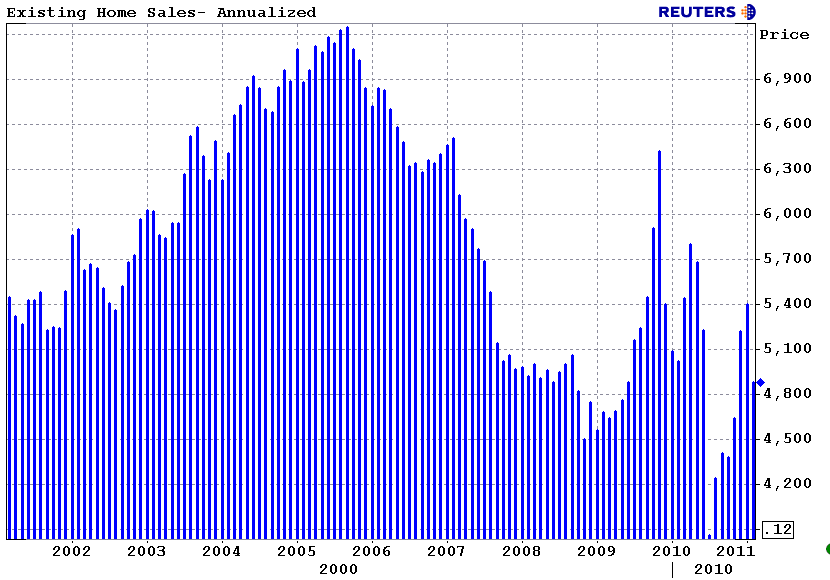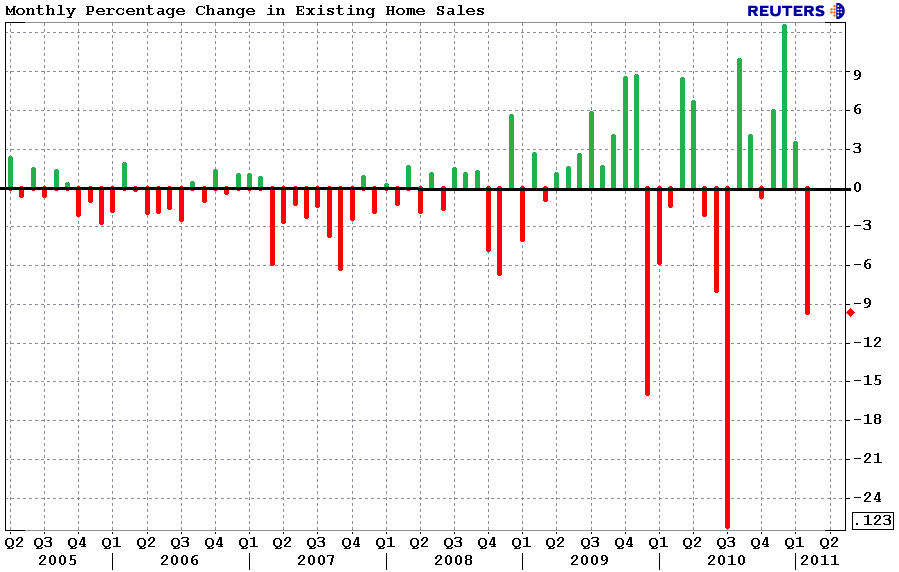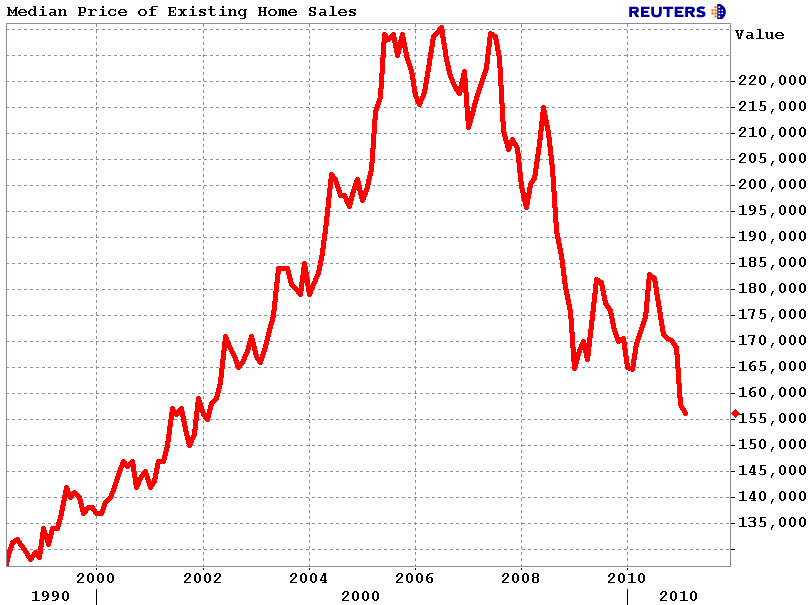The National Association of Realtors today released Existing Home Sales data for February 2011
Existing Home Sales report on the number of completed real estate sales transactions on single-family homes, townhomes, condominiums and co-ops. The methodology in calculating existing-home sales statistics is really quite simple. Each month the National Association of Realtor® receives data on existing-home sales from local associations/boards and multiple listing services (MLS) nationwide. The monthly EHS economic indicator is based on a representative sample of 160 Boards/MLSs. NAR captures 30-40% of all existing-home sale transactions with its monthly survey.
HERE is the methodology for the data collection
Reuters Quick Recap...
RTRS-US FEB EXISTING HOME SALES 4.88 MLN UNIT ANNUAL RATE (CONS 5.15 MLN) VS JAN 5.40 MLN (PRV 5.36 MLN)-NAR
RTRS-US FEB EXISTING HOME SALES -9.6 PCT (CONS -4.0 PCT) VS JAN +3.4 PCT (PREV +2.7 PCT)-NAR
RTRS-US FEB INVENTORY OF HOMES FOR SALE +3.5 PCT TO 3.488 MLN UNITS, 8.6 MONTHS' SUPPLY-NAR
RTRS-US FEB NATIONAL MEDIAN PRICE FOR EXISTING HOMES $156,100, -5.2 PCT FROM FEB 2010-NAR
RTRS-US NAR SAYS 39 PCT OF U.S. FEB EXISTING HOME SALES WERE DISTRESSED SALES, HIGHEST SINCE APRIL 2009, VERSUS 37 PCT IN JAN
RTRS-US FEB EXISTING HOME SALES MEDIAN PRICE LOWEST SINCE APRIL 2002
RTRS-TABLE-U.S. Feb existing home sales fell 9.6 pct

Excerpts from the Release...
Existing-home sales fell in February following three straight monthly increases, according to the National Association of REALTORS®.
Existing-home sales dropped 9.6 percent to a seasonally adjusted annual rate of 4.88 million in February from an upwardly revised 5.40 million in January, and are 2.8 percent below the 5.02 million pace in February 2010.

Single-family home sales fell 9.6 percent to a seasonally adjusted annual rate of 4.25 million in February from 4.70 million in January, and are 2.7 percent below the 4.37 million pace in February 2010.
Existing condominium and co-op
sales dropped 10.0 percent to a seasonally adjusted annual rate of
630,000 in February from 700,000 in January, and are 3.1 percent lower
than the 650,000-unit level one year ago.
Regionally,
existing-home sales in the Northeast fell 7.2 percent to an annual pace
of 770,000 in February and are 8.3 percent below February 2010. Existing-home sales in the Midwest dropped 12.2 percent in
February to a level of 1.01 million and are 9.0 percent lower than a
year ago. In the South, existing-home sales
fell 10.2 percent to an annual pace of 1.84 million in February but are
unchanged from February 2010. Existing-home sales
in the West declined 8.0 percent to an annual level of 1.26 million in
February and are 2.4 percent below a year ago.
Lawrence Yun NAR chief economist, expects an uneven recovery. “Housing affordability conditions have been at record levels and the economy has been improving, but home sales are being constrained by the twin problems of unnecessarily tight credit, and a measurable level of contract cancellations from some appraisals not supporting prices negotiated between buyers and sellers,” he said. “This tug and pull is causing a gradual but uneven recovery. Existing-home sales remain 26.4 percent above the cyclical low last July.”
Below is a chart illustrating the month over month volatility in Existing Home Sales.

Total housing inventory at the end of February rose 3.5 percent to 3.49 million existing homes available for sale, which represents an 8.6-month supply at the current sales pace, up from a 7.5-month supply in January.

The national median existing-home price for all housing types was $156,100 in February, which is 5.2 percent below February 2010. The median existing single-family home price was $157,000 in February, which is 4.2 percent below a year ago. The median existing condo price was $150,400 in February, down 11.1 percent from February 2010.
The median price in the Northeast was $230,200, down 9.5 percent from a year ago. The median price in the South was $134,600, down 3.9 percent from a year ago. The median price in the Midwest was $122,000, which is 5.4 percent below February 2010. The median price in the West was $190,000, which is 5.2 percent below January 2010.
This is the lowest Median price since April 2002.

All-cash sales were a record 33 percent in February, up from 32 percent in January; they were 27 percent in February 2010. Investors accounted for 19 percent of sales activity in February, down from 23 percent in January; they were 19 percent in February 2010. The balance of sales were to repeat buyers. A parallel NAR practitioner survey shows first-time buyers purchased 34 percent of homes in February, up from 29 percent in January; they were 42 percent in February 2010.
Distressed homes – sold at discount – accounted for a 39 percent market share in February, up from 37 percent in January and 35 percent in February 2010. “The decline in price corresponds to the record level of all-cash purchases where buyers – largely investors – are snapping up homes at bargain prices,” Yun explained. “We’d be seeing greater numbers of traditional home buyers if mortgage credit conditions return to normal.”
Plain and Simple: 33% of existing home sales in February were covered with cold, hard cash. 39% of all sales were distressed inventory. This indicates folks are looking for bargains before the spring/summer buying season gets underway. Adding some optimism to the home buying outlook, we're hearing from loan originators that purchase applications are on the rise with most settlements not scheduled until April and May. Unfortunately, on the whole, optimism is tempered by tighter underwriting standards and weak consumer credit profiles. This is old news though. It's not only hurting home buying demand, it's preventing many folks from refinancing into a lower monthly payment as well. There's a lot of borrowers out there who just can't qualify for an agency-backed loan. Anyone know of a better alternative besides cash? We don't....







